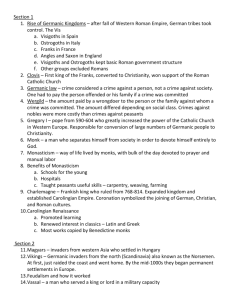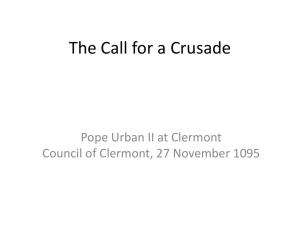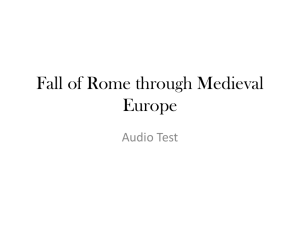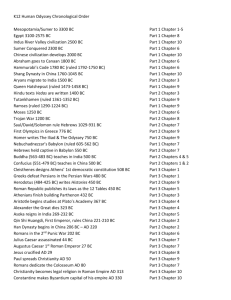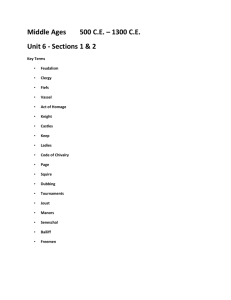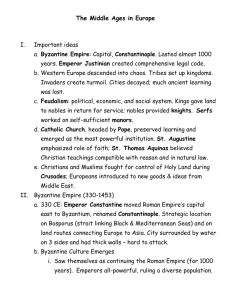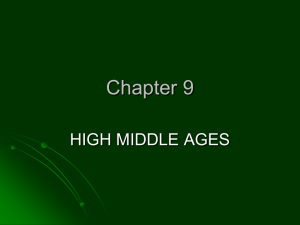Medieval Europe Introduction
advertisement
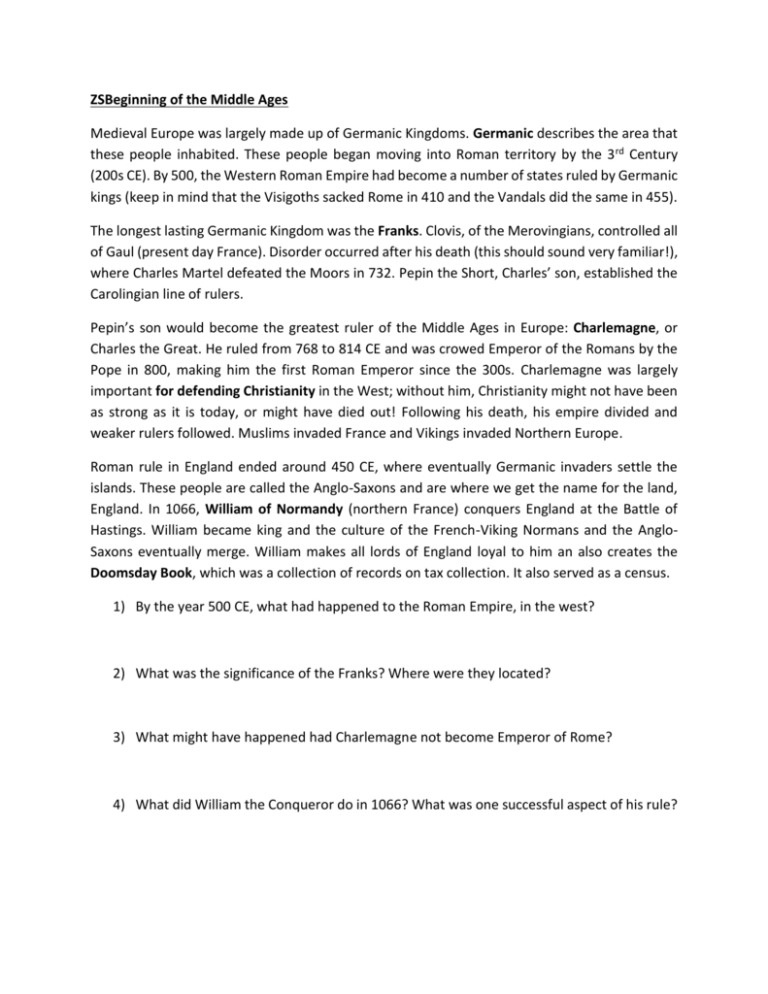
ZSBeginning of the Middle Ages Medieval Europe was largely made up of Germanic Kingdoms. Germanic describes the area that these people inhabited. These people began moving into Roman territory by the 3 rd Century (200s CE). By 500, the Western Roman Empire had become a number of states ruled by Germanic kings (keep in mind that the Visigoths sacked Rome in 410 and the Vandals did the same in 455). The longest lasting Germanic Kingdom was the Franks. Clovis, of the Merovingians, controlled all of Gaul (present day France). Disorder occurred after his death (this should sound very familiar!), where Charles Martel defeated the Moors in 732. Pepin the Short, Charles’ son, established the Carolingian line of rulers. Pepin’s son would become the greatest ruler of the Middle Ages in Europe: Charlemagne, or Charles the Great. He ruled from 768 to 814 CE and was crowed Emperor of the Romans by the Pope in 800, making him the first Roman Emperor since the 300s. Charlemagne was largely important for defending Christianity in the West; without him, Christianity might not have been as strong as it is today, or might have died out! Following his death, his empire divided and weaker rulers followed. Muslims invaded France and Vikings invaded Northern Europe. Roman rule in England ended around 450 CE, where eventually Germanic invaders settle the islands. These people are called the Anglo-Saxons and are where we get the name for the land, England. In 1066, William of Normandy (northern France) conquers England at the Battle of Hastings. William became king and the culture of the French-Viking Normans and the AngloSaxons eventually merge. William makes all lords of England loyal to him an also creates the Doomsday Book, which was a collection of records on tax collection. It also served as a census. 1) By the year 500 CE, what had happened to the Roman Empire, in the west? 2) What was the significance of the Franks? Where were they located? 3) What might have happened had Charlemagne not become Emperor of Rome? 4) What did William the Conqueror do in 1066? What was one successful aspect of his rule? Law and Church Order Common Law became a popular system in England, and stated that laws be based on precedent rather than statutes. Henry the First, of England, would send judges to travel and decide cases. The significance of this was that it took power from the nobles. Edward I later had court records collected so they could be compared and applied equally and in common to all. This legal system allows change over time on different issues. Thomas Beckett, an Archbishop, or leader in the Church (the Catholic Church) got into conflict with the king over the king’s power to judge the church officials. Beckett, for his protests, gets assassinated by the king’s men, at which point the Church canonizes him (makes him a saint). King John began demanding more taxes from his nobles, at which point they rebelled. In 1215, the nobles forced him to sign the Magna Carta, a contract that listed the rights of the nobility and limited powers of the king. Out of this document England receives Parliament, a system of government that contains two houses: The House of Lords, whose members were part of lineage and the House of Commons, whose members are elected to represent certain districts. Back in France, they experienced the last Carolingian king in 987. A man named Hugh Capet is chosen as king who created the Capetian Dynasty, centralized around Paris. Eventually a Parlement was established in Paris (not to be confused with Parliament), which was the highest court of the king. Medieval France also produced the Three Estates: the Clergy, Nobles, and Commoners. Each of these groups had equal representation in French government. The Holy Roman Empire arose out of the old Roman Empire. This Empire, however, was neither Holy, Roman, nor… an Empire. Germanic Kings ruled over both Germany and areas of northern Italy (but not Rome, which was controlled by the Pope/Church) and really only paid a small fee to the Emperor. Struggles between the Emperor and the Pope arose and German princes and nobles created many small states. Neither area becomes unified until the last half of the 1800s. 1) How does common law differ from Hammurabi’s Code of Laws? 2) What could be compared to the Magna Carta that is part of the U.S. Government structure? What could you compare Parliament to in U.S. Government? 3) What could be an issue with splitting the population into three groups that would share equal representation? 4) What is ironic about the Holy Roman Empire? (Why is it funny that we call this Empire the Holy Roman Empire?) Feudalism The development of the feudal system started around the same time that organized government had faded away. Foreign invaders posed a safety threat to small towns, where nobles and aristocrats (the wealthy people) offered protection and safety to poorer peasants. This new political system became known as feudalism. Grants of land offered by someone to a lower noble is a process known as vassalage. The term fief describes something, usually a piece of land that was for use, not for owning. This would be given to peasants so that they could work the land. This created loyalty to one’s lord. Life in feudalism was not great. Life expectancy was short and there were many wars, famines, and diseases. Not all nobles lived in luxury, as might be expected. Those that did live in castles lived in cold, dark, damp rooms with little warmth. Feudal justice was different than Roman law, meaning that not all citizens were viewed equally under the law. Trials by battle often took place, called jousts, or by other means, like tournaments. The manor was a large plantation where the peasants spent most of the time in agriculture. The manor was largely self-sufficient, meaning they kept themselves running. Women had few legal rights and many women managed the households. Peasants in general were bound to the lord’s estate and increasing numbers of free peasants became serfs. Lords had a variety of legal rights over serfs, but serfs were not slaves. Because of the emphasis on agriculture, the number of people in Europe doubled between the years of 1000 to 1300. A climate change improved growing conditions and more land was cleared for cultivation. Peasant life was very simple and they ate simply as well, often eating only bread and ale, where meat was rarely eaten. There were lots of holidays and feasts to celebrate harvest time. 1) What is feudalism? 2) What is a fief? 3) How was Roman law different than feudal justice? 4) Why did Europe double in population? Give two reasons. Crusades The Crusades, as they became known, started when Pope Urban the Second instructed Christians to take the ‘Holy Land’ back from the Turks, which had taken control of the Palestine region. The Turks then threatened to take the Byzantine Empire, which had been controlled by Christians. The Crusades describe military campaigns to regain the Holy Land. The Pope wanted to provide leadership for a cause to unite European Christians. The First Crusade regained Jerusalem for the Christians in 1099, which involved the slaughter of countless Muslim and Jewish people. The Second Crusade in the 1140s failed and by 1187, Jerusalem fell to the Muslims, led by Saladin. The Third Crusade was a plan to take back Jerusalem, which involved Frederick Barbarossa (the Holy Roman Emperor), Philip II (King of France), and Richard I (King of England) leading crusaders into battle. Richard the First was captured and ransomed back to the English. During the Fourth Crusade, the crusaders sacked Constantinople in 1204 in a last ditch attempt to take territory for the Christian world. Because of this, the Byzantine Empire began to fade away. There were a total of 9 separate crusades and even a Childrens’ Crusade, where thousands of children were promised salvation to attack Muslim cities, many of whom died or were kidnapped and sold into slavery along the way. Because of the increase of trade due to travelers and weapons production, Italian cities (geographically located to serve the Christians as they went into battle) become very wealthy. The Pope’s leadership also increases immensely because he promises crusaders access to heaven for their service. Monarchs of nations gain more power because their loyal nobles die in combat leaving their land in the power of the king. 1) Who ordered the First Crusade? 2) Who led the Muslims during the Second Crusade? 3) What three leaders were in charge of the Third Crusade? 4) What happened following the “Childrens’ Crusade”? 5) What 3 separate things gained power and wealth because of the Crusades?


